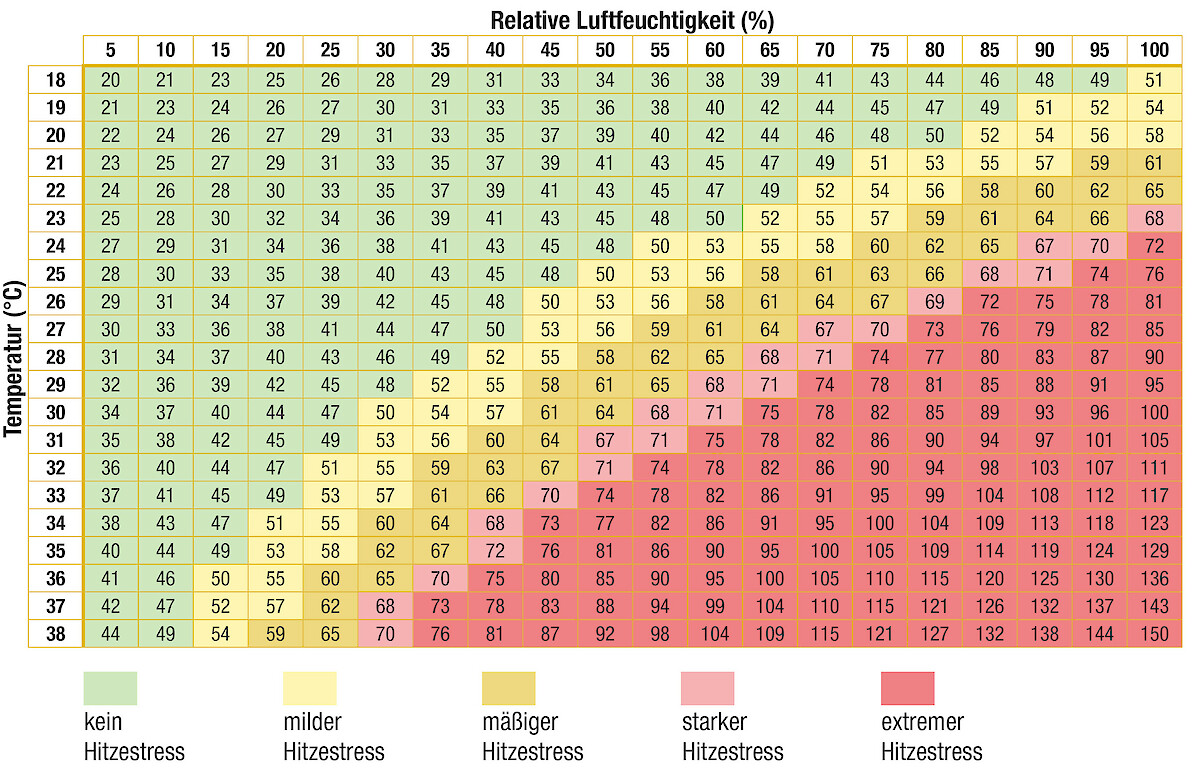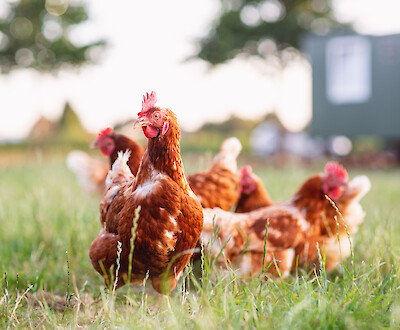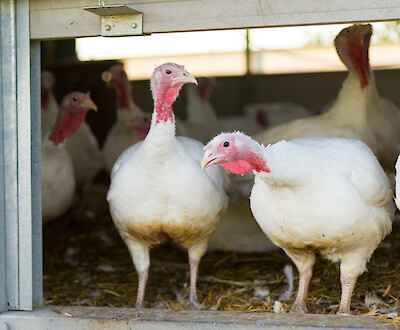With the right feeding and adapted management against heat in the house
Heat stress in poultry - act correctly! But how?
Heat stress in poultry is on the rise. In recent years, periods of extreme heat stress have occurred more frequently. However, high outdoor temperatures have negative effects on the well-being and health of laying hens, chickens, turkeys, geese and ducks - especially in combination with high humidity. Heat sometimes noticeably reduces animal welfare and often causes reduced flock performance. Depending on the weather conditions, high animal losses are a possible consequence. Farm managers should therefore take a close look at the issue of heat stress, its consequences and the options available to remedy the situation. This article offers orientation.
At what temperatures does one speak of heat stress in poultry?
Temperatures above 27°C mean heat stress for poultry. This intensifies with increasing humidity. However, even moderate temperatures (approx. 25°C) in conjunction with very high humidity (approx. 80%) can exceed the threshold for heat stress. On hot summer days, when there is no pleasant cooling at night, the herd suffers particularly badly. Older animals are particularly affected. Laying hens, turkeys (from the 14th week of life), broilers (from the 20th day of life), and parent birds regardless of age suffer particularly. In contrast, laying hens, turkeys, and chickens feel comfortable at moderate temperatures (< 25°C) and lower humidity (< 40%). This temperature range is also referred to as the thermoneutral zone and is considered the "comfort zone" for the flock.
Enthalpy - A key figure for heat stress in poultry?
The German Meteorological Service (DWD) has developed a special indicator to describe and better assess heat stress. The so-called "enthalpy" is an indicator for the heat stress of poultry, which is determined with the help of temperature and relative humidity. It indicates the total heat content of the outside air, which results from the temperature and the relative humidity. Enthalpy is usually expressed in kilojoules (kJ) per kilogram (kg). The higher the temperature and relative humidity, the faster a critical enthalpy value (> 50 kJ/kg or > 67 kJ/kg) is reached.
Classes of heat stress based on enthalpy values
|
Enthalpy (kJ/kg) |
Description |
|
< 50 |
no heat stress |
|
50 bis < 58 |
mild heat stress |
|
58 bis < 67 |
moderate heat stress |
|
67 bis < 72 |
severe heat stress |
|
≥ 72 |
extreme heat stress |
Source: Deutscher Wetterdienst (DWD)
An enthalpy of 67 kJ/kg is the critical upper limit. However, such a value in the outside air can already mean an enthalpy of 72 kJ/kg in the house. If this value is exceeded, heat death occurs in poultry after only a short time.
The daily values are published every year in summer - usually between May and September - on the DWD website for all regions in Germany (including a four-day forecast). With the help of this indicator, poultry farmers throughout Germany can prepare for extreme weather conditions and thus prevent heat stress in their flocks.
Enthalpy table shows heat stress in poultry

How does heat stress develop in poultry?
Poultry do not have sweat glands. Unlike humans, poultry cannot regulate their body temperature by perspiration. This becomes a problem when temperatures rise. The more muscle mass poultry has, the more heat is produced and stored in it. In addition, the plumage of poultry has an insulating effect, which reduces temperature release. If the animals consume a lot of feed, additional endogenous heat is produced with digestion. Above the thermoneutral zone, poultry is then no longer able to release excess heat in sufficient quantity to the environment. As a result, the animals' body temperature rises up to 43-44°C (normal temperature: ~41°C). The animals become dehydrated and the blood vessels are severely dilated. This leads to circulatory failure and then to heat death (see following section).
Symptoms of heat stress in poultry
When ambient temperatures are high, poultry try to release more of their body heat into the environment. Since poultry do not have sweat glands, laying hens, turkeys, geese, ducks and the like try to cool themselves in other ways. Typical behaviors that can be used by farm managers to identify heat stress are
- high respiratory rate
- increased panting
- increased water intake (caused by fluid loss during panting)
- spreading of wings and feathers
- increased blood flow to the scalp (appears reddened)
- reduced mobility of the flock
- greater distances between individual animals
- stay of the flock in shady and cool areas of the run and stable
- reduced feed intake
The threatening consequences of excessive heat stress in poultry
In particular, reduced feed intake (in extreme cases up to 30% in turkeys) endangers animal welfare in the flock and the economic success of the farm. It leads to lower daily gains for poultry in fattening. In laying birds, this leads to a decrease in laying performance combined with lower egg weights and poorer egg shell stability. As a result, the nutrient supply is often inadequate and the electrolyte balance is increasingly upset.
Stressed poultry therefore suffer from a weakened immune system. In addition to a drop in performance, affected birds often suffer from diseases such as E. coli infections, feather losses (neck moult), and stress-related behavioral disorders such as feather pecking and cannibalism. If measures are not taken, severe heat stress can lead to circulatory failure and thus to death of the animals.
Proper management and adapted feeding against heat stress in poultry
Heat stress is a recurring annual challenge that can be addressed with a number of different measures. Adjusting operational procedures at different points offers relief for poultry flocks. Farm managers should consider individually which measures are appropriate for their farm.
-
Hot temperatures and high humidity put a strain on the circulation of laying poultry as well as poultry during fattening. To relieve the strain, it can be useful to adjust the feeding times. During hot spells, you should only fill the troughs in the house during the cooler evening hours. This allows the birds to take in the feed until the first heat of the morning. For fattening poultry, it is advisable for this reason to withdraw feed from eight o'clock in the morning. This adjustment of the day-night rhythm shifts the flock's resting periods to the hot hours of the day.
To care for poultry in fattening, farm managers should also consider feeding a summer diet that supports the performance of the fattening animals. Appropriate feeds for animals in fattening are particularly concentrated in nutrients to compensate for reduced feed intake on hot days. In this way, farm managers avoid deficiency symptoms with all the unpleasant consequences. Summer feeds for laying hens, on the other hand, are characterized by a higher vitamin content (especially vitamin C), which supports the immune system of heat-stressed animals. If you use such feeds on your farm and also use drinking water additives, be sure to coordinate the dosage in advance with the veterinarian in charge of the flock.
-
Securing water supply during hot periods is vital for poultry. The birds need Securing water supply during hot periods is vital for poultry. The birds need access to cool water day and night (temperature: about 10-12 degrees). On hot days, flush water lines with cool water several times a day. Water in storage tanks (e.g., when keeping laying hens in mobile houses) can heat up easily on hot days and sometimes considerably. Therefore, ideally, replace the water with fresh, cooled water daily on summer days.
Since water intake is sometimes greatly increased in spring and summer, adjust the flow rate in the water lines if necessary. Even at the last nipple of the watering line, you must ensure sufficient water pressure to supply all animals in the herd equally.
-
Heat stress puts a strain on the circulation and causes stress in the poultry flock. Farm managers are therefore well advised to eliminate further stressors on their farms so as not to place additional strain on the flock. For this reason, you should at least pause all non-essential work on the farm during hot spells. This includes mucking out, for example. If work is necessary, it should ideally be carried out in the cool morning hours (e.g. fresh bedding). Stabling and unstabling is also best done in the morning or at night. If appropriate, you should slaughter the particularly endangered turkey finishing roosters prematurely.
-
Depending on the geographic location and construction of the barn, the heat load can vary greatly. Design ventilation to achieve adequate air exchange in the animal area, i.e., to provide sufficient fresh air and remove excess heat. If this cannot be ensured, farm managers should consider purchasing a cooling system or review the space available for the animals. This is especially true for animals in the finishing phase.
-
Always check the functionality of the technical equipment in your plant. Schedule maintenance work and outstanding repairs promptly. The Corona crisis has shown that interruptions in the supply chain can quickly lead to delivery bottlenecks, delays and breakdowns. Ideally, buy spare parts for safety-critical equipment in stock rather than when you need them.
Digital systems make it easier to check and monitor operations. However, network problems, power outages or severe weather can jeopardize operational processes as well as the overall functioning of the business. Therefore, don't blindly trust technology. Instead, regularly verify that all areas of the barn are functioning properly. A functioning emergency generator is important for power supply in case of an emergency, and an alarm system that is always ready for use should also be in place.
-
By checking and evaluating the weather forecast daily, you can protect yourself from surprises. Make sure that an animal caretaker is always on call in case of extreme weather conditions. This way you will have support directly at hand and can act immediately in case of incidents.
At the same time, encourage the poultry to get up regularly by carrying out additional checks during the day. In this way, you facilitate the removal of stagnant heat and at the same time encourage the birds to take in additional water.
Herbal drinker additives support poultry during heat stress
Heat stress has a negative impact on the performance and physiology of poultry. Under heat stress, the respiratory frequency of the animals increases up to tenfold (panting or throat fluttering). Studies have shown that plant extracts and so-called phytomolecules can have a liberating effect on respiration. These include, for example, methol, cineol and anethol. The chemical compounds are found in nature in plants such as eucalyptus, peppermint or fennel or in the essential oils extracted from them. They have positive effects on the respiratory tract, have an expectorant and antibacterial effect. They can be administered with the help of appropriate drink additives (e.g. Incona Respirum) and thus provide support especially in phases of great heat stress.
Conclusion: Heat stress in poultry - act correctly! But how?
- In summer, heat stress can negatively affect the health and performance of your poultry flocks.
- Heat stress in poultry begins when outside temperatures and relative humidity exceed a certain level. Details are provided in a table from the German Weather Service (see above).
- An important indicator for determining heat stress is enthalpy, which is published regularly by the Deutscher Wetterdienst (DWD).
- If heat stress is left untreated in laying and fattening poultry alike, there is a risk of serious consequences - from an increased incidence of infections to reduced performance and even death of the animals.
- Farm managers should take countermeasures and reduce stress in the flock with various measures, in which the changeover to summer feeding also plays an important role.
- Switching to a summer feed can be a good idea. Ask your feeding advisor.
Further links
Contact person

Contact person


























